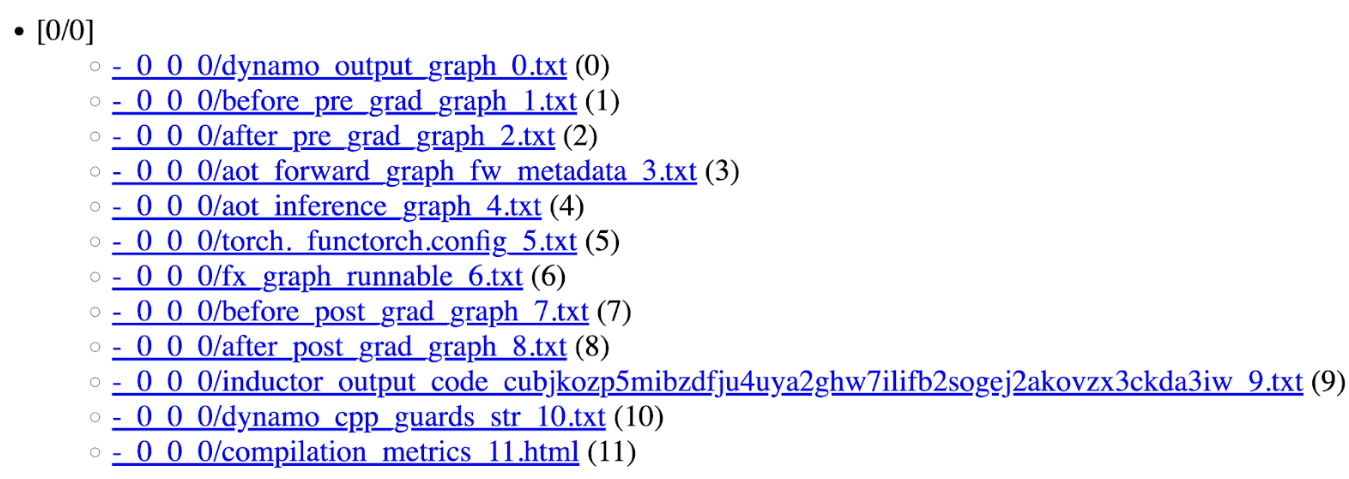Debugging with tlparse and TORCH_LOGS=dynamic#
Created On: Sep 22, 2025 | Last Updated On: Sep 22, 2025
tlparse is a tool used for analyzing and understanding the compilation
process in PyTorch, particularly when dealing with dynamic shapes. It helps
identify where guards and specializations occur in your code.
TORCH_LOGS=dynamic is an environment variable setting that enables detailed
logging of dynamic shape operations, providing insights into how symbolic
shapes are handled during execution.
This section will guide you through using tlparse and TORCH_LOGS=dynamic to
troubleshoot dynamic shape issues in your code, including debugging
specialization, guards, and more.
Debugging Specialization#
In the following example, x.shape[0] is dynamic but becomes specialized due to multiplication:
import torch
@torch.compile
def fn(x, y):
return x * y
x = torch.randn(5)
y = torch.randn(5)
torch._dynamo.decorators.mark_dynamic(x, 0)
fn(x, y)
By using TORCH_LOGS=dynamic, you can observe this specialization in the logs:
TORCH_LOGS=dynamic python tl.py
I0721 11:10:00.950000 845259 torch/fx/experimental/symbolic_shapes.py:3776] [0/0] create_env
I0721 11:10:01.030000 845259 torch/fx/experimental/symbolic_shapes.py:5117] [0/0] create_symbol s77 = 5 for L['x'].size()[0] [2, int_oo] return x * y # tl.py:5 in fn (_dynamo/variables/builder.py:3466 in <lambda>), for more info run with TORCHDYNAMO_EXTENDED_DEBUG_CREATE_SYMBOL="s77" or to suppress this message run with TORCHDYNAMO_EXTENDED_ADVICE="0"
I0721 11:10:01.038000 845259 torch/fx/experimental/symbolic_shapes.py:7211] [0/0] eval Eq(s77, 5) [guard added] return x * y # tl.py:5 in fn (_subclasses/fake_impls.py:922 in infer_size), for more info run with TORCHDYNAMO_EXTENDED_DEBUG_GUARD_ADDED="Eq(s77, 5)"
The line eval Eq(s77, 5) [guard added] return x * y # tl.py:5 indicates the specialization.
Debugging Guards#
Consider the following code, which may cause recompilations due to dynamic shapes:
import torch
@torch.compile
def fn(x, y):
if x.shape[0] < 10:
return x * y
x = torch.randn(5)
y = torch.randn(5)
torch._dynamo.decorators.mark_dynamic(x, 0)
torch._dynamo.decorators.mark_dynamic(y, 0)
fn(x, y)
To identify where dynamic shape guards originate, use tlparse. Here is an example tlparse output:

By clicking on the dynamo_cpp_guards link, you can view all guards from the compilation, including the symbolic shape guard L['x'].size()[0] <= 9.
Astute readers will notice the 0/1 specialization where we guard on L['x'].size()[0] >= 2. By modifying the code to use unbacked symbols, this guard is removed:
import torch
@torch.compile
def fn(x, y):
# Necessary runtime assert since we can't guard on unbacked
torch._check(x.shape[0] < 10)
if x.shape[0] < 10:
return x * y
x = torch.randn(5)
y = torch.randn(5)
torch._dynamo.decorators.mark_unbacked(x, 0)
torch._dynamo.decorators.mark_unbacked(y, 0)
fn(x, y)
Now, this compiled region can be used for inputs of size 0 and 1:

